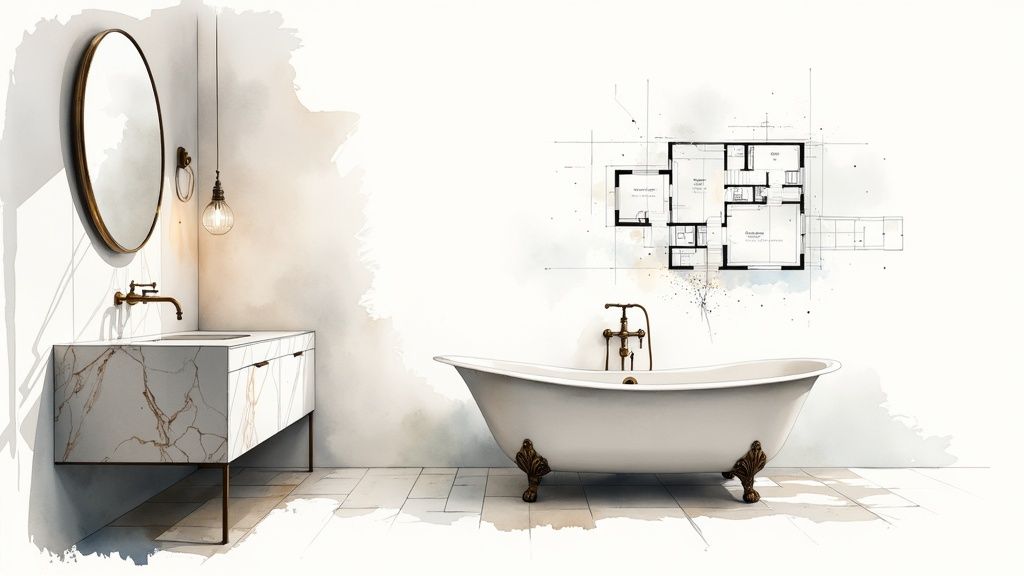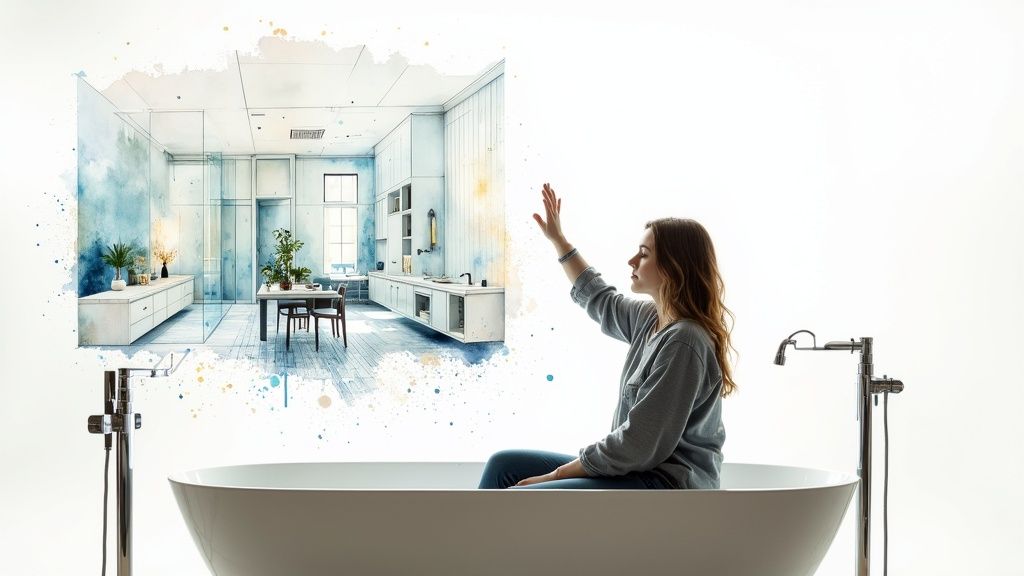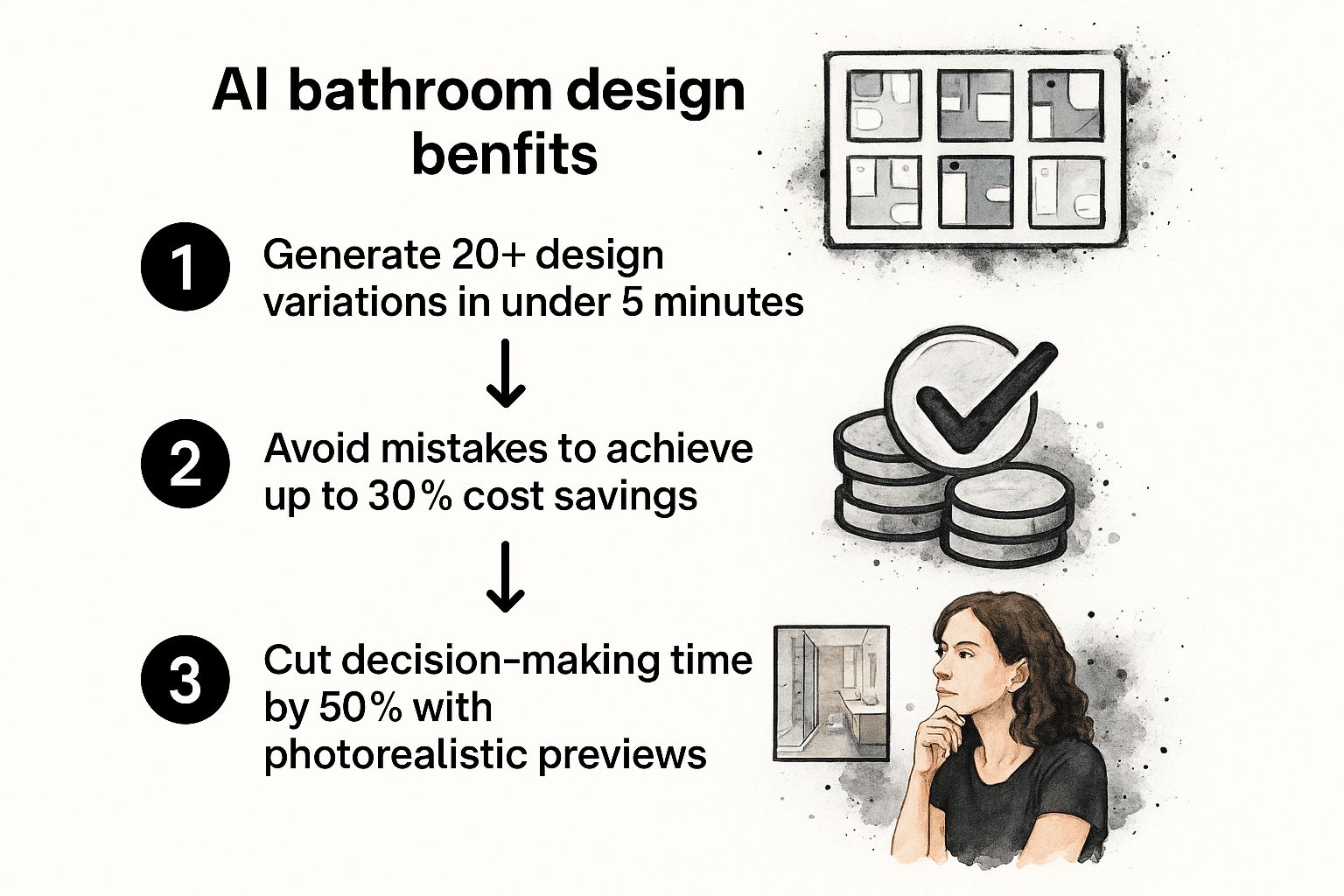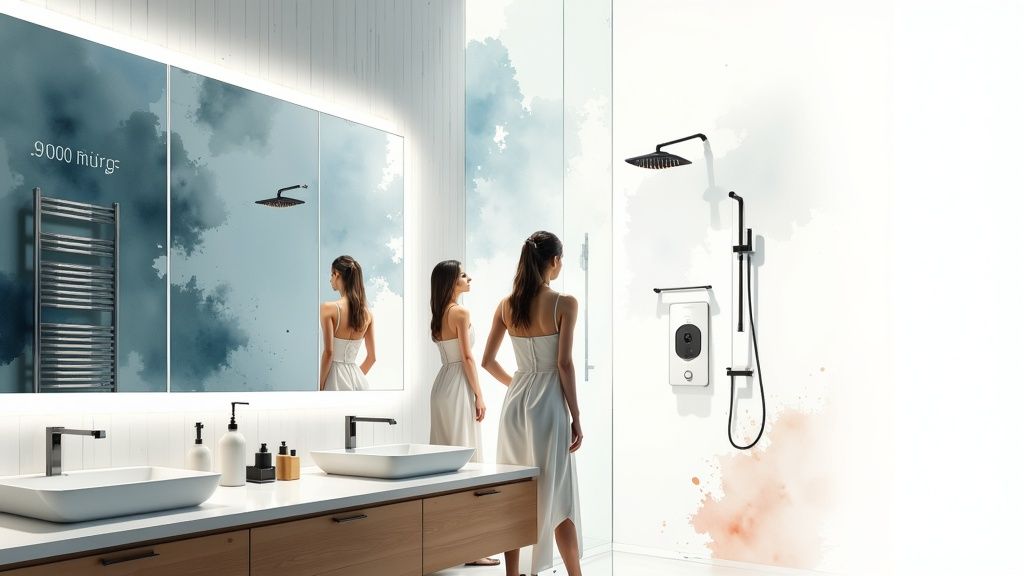Your Guide to AI Bathroom Design

Ever wondered what your dream bathroom could look like, but struggled to picture it? That’s where AI bathroom design comes in. Think of it as specialized software that acts like your personal design consultant, creating an endless stream of renovation concepts. It helps you visualize different layouts, styles, and materials long before a single tile is laid.
This isn’t just about moving boxes around on a screen. This technology is a creative partner that can take a simple text description or a photo of your current space and turn it into a set of stunning, photorealistic renderings in just a few minutes.
The Future of Remodeling Is Already Here

Imagine having a team of expert interior designers and architects on call 24/7, ready to brainstorm ideas for your new bathroom. That’s the power of AI bathroom design. What once felt like a futuristic concept is now a very real, practical tool for homeowners. We’re moving away from guesswork and expensive missteps and into an era of making smart, confident decisions.
In this guide, I’ll walk you through how AI can be your creative co-pilot. You’ll learn how to visualize ideas, fine-tune layouts, and select materials with incredible speed and accuracy. It makes the whole remodeling process more approachable, more creative, and—honestly—a lot more fun.
How AI Simplifies Your Renovation
The real magic of AI here is its ability to crunch massive amounts of data. We’re talking thousands of design styles, fixture types, and color palettes—all synthesized into concepts that are unique to you. Instead of spending weeks flipping through magazines or wandering showrooms, you can generate dozens of distinct styles in a single afternoon. This rapid-fire ideation lets you explore possibilities you might never have thought of on your own.
Here’s where it really shines:
- Speed and Efficiency: Get multiple design options in minutes, not days.
- Cost-Effectiveness: See how changes look before the demolition starts, which helps avoid costly mistakes. Poor design choices can eat up up to 30% of a renovation budget, so this is a huge win.
- Personalization: Create designs that truly fit your taste, your room’s exact dimensions, and how you actually use the space.
At its best, AI serves as an incredible starting point for inspiration. It can suggest layouts, color palettes, and furniture ideas, but it doesn’t understand your unique space, lifestyle, or personal preferences the way a real designer does. It’s a helpful starting point, not a full solution.
As we look ahead, embracing new ways to upgrade our homes is key, and AI is set to improve everything from the initial planning to the final execution. For more practical insights into modern home improvement, check out these transformative bathroom renovation ideas.
Let’s dive into the process and empower you to create a bathroom you’ll absolutely love.
How AI Is Reinventing Bathroom Design

Let’s break down how AI actually works in bathroom design, minus the tech-speak. The simplest way to think about it is like a master chef who has memorized thousands of recipes. But instead of food, the AI has learned from massive libraries of design elements—styles, materials, color schemes, and layouts—to cook up functional and beautiful concepts just for you.
It all starts with your “recipe,” which is just a simple text description. You might tell it, “I want a modern farmhouse bathroom with a clawfoot tub and brass fixtures.” The AI then dips into its knowledge base, pulling together relevant images and design rules to generate a picture of your idea in seconds.
This is where AI bathroom design really starts to feel like magic for homeowners. You’re no longer just guessing what a concept might look like; you’re actually seeing it.
From Simple Prompts to Smart Solutions
But AI’s real strength goes way beyond just creating pretty pictures. The more sophisticated platforms can take your room’s precise measurements and figure out the best possible layouts, solving tricky spatial puzzles that would give most of us a headache. It can show you the perfect spot for a vanity to open up floor space or instantly visualize how different tile patterns will look on your specific walls.
This is the point where the technology goes from being a cool toy to a genuinely practical planning tool. The AI isn’t just playing decorator; it’s actively solving problems. It can spot potential issues—like a door that won’t open all the way because the toilet is in the way—before you’ve spent a dime on materials. To see more tools with these features, check out our guide on the best AI interior design software.
”AI can suggest layouts, color palettes, and furniture ideas, but it doesn’t understand a unique space, lifestyle, or personal preferences the way a real designer does. It’s a helpful starting point, not a full solution.”
A Creative Partner, Not a Replacement
At the end of the day, AI is best thought of as a creative partner. It gives you perspectives you might not have thought of and takes care of the grunt work of mocking up different options. This frees you up to focus on what really matters. It can generate a dozen variations of a Japandi-style bathroom in a minute, each slightly different, helping you pinpoint exactly what you like.
Of course, even with these incredible tools, a good grasp of the fundamental principles of architectural design is still essential for creating a space that truly works. The AI can give you the “what,” but it takes a human to understand the “why.” When you blend your personal vision with the AI’s speed, you get a bathroom design that isn’t just stunning but is perfectly tailored to your life.
Key Benefits of Using AI for Your Bathroom Project
Bringing AI into your bathroom remodel isn’t just a gimmick; it delivers real-world advantages that can save you a ton of time, money, and headaches. Think of it less as a novelty and more as a practical partner for your project. One of the most immediate wins is the sheer speed—you can generate dozens of completely different design concepts in minutes. That’s a process that used to take weeks of gathering swatches and consulting with designers.
This isn’t just about playing around with ideas, either. This rapid-fire iteration is a powerful way to sidestep costly mistakes. By seeing an almost-real version of the final room, you can try out that bold tile or unconventional layout without spending a dime. Swapping a vanity on a screen is free; doing it after the plumbing is installed is a budget-busting nightmare.
Save Time and Reduce Costs
The efficiency of AI bathroom design leads directly to real savings. Instead of getting stuck in a cycle of indecision, you can quickly see what works and what doesn’t, drastically shortening the planning process. In fact, many people find they can cut their design and decision-making time by as much as 50% because the AI gives them a clear, visual roadmap right from the beginning.
This infographic shows just how the process works to deliver better results and protect your wallet.

Ultimately, moving from a rough idea to a photorealistic preview helps you catch common remodeling mistakes before they happen. This means you can move forward with confidence, knowing your investment is going into a design you’ve already seen and approved.
Personalize Every Detail
Another huge plus is the incredible level of personalization AI can bring to the table. It’s like having a design assistant that instantly gets your style. You can upload a picture of a spa you love or a specific color palette you’ve been dreaming of, and it will churn out concepts that are truly unique to you. The technology is fantastic at bridging that tricky gap between what’s in your head and a concrete, buildable plan.
To really see the difference, let’s compare the old way of doing things with the new AI-powered approach.
Traditional vs AI-Powered Bathroom Design Process
| Design Aspect | Traditional Method | AI-Powered Method |
|---|---|---|
| Initial Concepts | Weeks of mood boards, magazines, and showroom visits. | Generate dozens of unique concepts in minutes from a photo or text prompt. |
| Visualization | 2D sketches or hiring a professional for expensive 3D renders. | Instantly create photorealistic visuals of the finished space. |
| Revisions | Slow and often costly. Redrawing plans or re-rendering takes significant time. | Make changes and see new versions in seconds, allowing for unlimited iteration. |
| Material Selection | Physically collecting samples of tiles, paint, and fixtures. | Virtually swap materials and finishes to see how they look in your actual space. |
| Cost & Time | High costs for professional design services and a lengthy planning phase. | Low-cost subscription tools and a planning phase reduced by up to 50%. |
This comparison makes it clear: AI doesn’t just speed things up, it fundamentally changes how you can interact with and refine your ideas, giving you more creative control and certainty.
This level of personalization also extends to integrating the latest smart home features. The smart bathroom market is booming and is expected to hit a staggering USD 39,002.1 million by 2035. AI tools are perfect for figuring out the best placement for smart toilets, sensor-activated faucets, and digital showers, making sure these modern touches feel like a natural part of your design. You can dive deeper into this trend by checking out the full research on the smart bathroom market.
At the end of the day, using AI gives you a crystal-clear vision and a solid plan, making the journey to your dream bathroom a whole lot smoother and more predictable.
A Step-By-Step Guide to Designing with AI
Diving into AI bathroom design might sound intimidating, but it’s actually more like having a focused chat with a super-fast interior designer. The whole process is surprisingly logical. Let’s walk through the steps to take your vague ideas and turn them into a solid visual plan you can actually use.
Step 1: Gather Your Inspiration
Before you touch any software, figure out what you love. What kind of vibe are you going for? Spend some time browsing for images that really speak to you. Maybe it’s the clean, calm feel of a Nordic spa, the dramatic flair of an art deco powder room, or the cozy charm of a farmhouse bathroom.
Create a small mood board on Pinterest or just save a handful of your favorite pictures. This collection isn’t just for you; it’s the visual language you’ll use to tell the AI what you want.
Step 2: Choose Your AI Tool
Next up, you need to pick your platform. There are a lot of options out there. Some are great for generating quick, artistic concepts from scratch. Others, like RoomGenius, are built to work with your actual space by letting you upload a photo of your current bathroom.
For this walkthrough, we’ll assume you’re using a tool that grounds the design in your room’s real dimensions.
Step 3: Prepare Your Digital Canvas
This is the most important part of the setup: measurements. Grab a tape measure and get the exact dimensions of your bathroom—length, width, and ceiling height. You’ll also need to note the precise location and size of doors, windows, and any unmovable plumbing features.
Don’t eyeball it. Getting this right is absolutely crucial. Accurate numbers stop the AI from suggesting beautiful layouts that simply won’t fit in reality. Most tools will have you plug these dimensions into a simple 2D floor plan creator. This becomes the digital blueprint for everything that follows.
Step 4: Craft the Perfect Prompt
Now for the fun part. Talking to an AI designer is a skill, and the secret is in the details. If you give it a vague prompt, you’ll get a generic, uninspired result.
Think about the difference between these two prompts:
- Weak Prompt: “Modern bathroom design.”
- Strong Prompt: “A bright, airy modern bathroom with a floating oak vanity, large terrazzo floor tiles, a walk-in shower with a frameless glass door, and matte black fixtures. Lots of natural light from a big window.”
A great prompt is like a detailed brief for a human designer. It sets clear expectations for the style, materials, key features, and overall mood, giving the AI the creative boundaries it needs to generate something genuinely useful.
Play around with it! See what happens when you change “terrazzo” to “slate” or “matte black” to “brushed brass.” This is where AI really shines—letting you explore tons of variations in seconds.
Step 5: Iterate and Finalize Your Design
The first images the AI spits out are rarely the final product. Think of them as brilliant first drafts. Your job is to look them over and decide what works and what doesn’t. Maybe you love the vanity it suggested but can’t stand the tile.
Use that feedback to tweak your prompt or use the platform’s editing tools to make targeted changes. This back-and-forth is how you refine the concept into something perfect. If you’re stuck for ideas, especially with a tricky layout, seeing how pros have handled similar spaces can be a huge help. You can find some fantastic inspiration in these pictures of remodeled small bathrooms to guide your final touches.
Once you have a look you’re thrilled with, the last step is to make it real. Many AI tools can generate a list of the types of fixtures, finishes, and furniture featured in the design. This gives you an actual shopping list, turning your AI-generated vision into a practical roadmap for your renovation project.
Choosing the Right AI Bathroom Design Tools
Picking the right AI platform is the first, and most important, step in your design journey. Not all tools are created equal, and the market is packed with options built for different jobs and skill levels. Think of it like a toolbox: you wouldn’t use a sledgehammer to hang a picture frame.
The trick is to match the tool to your goal. Are you just spitballing ideas and looking for a creative spark? Or do you need a precise plan that fits your bathroom’s exact dimensions? Figuring that out first will save you a world of headaches down the road.
Tools for Quick Visual Inspiration
This first group of tools is all about the brainstorming phase. They’re built for speed and creativity, letting you pump out dozens of concepts in minutes just by typing in a simple description. You could try something like, “a modern coastal bathroom with a freestanding tub and brass fixtures.”
These platforms don’t get bogged down in measurements. Their whole purpose is to nail the aesthetic—to be your digital mood board. They help you explore color schemes, textures, and material combinations you’d never have thought of on your own. They’re perfect for answering the question, “What could this space look like?”
Platforms for Detailed Room Planning
Once you’ve settled on a style, you need a tool that can ground your vision in reality. This is where the second category of AI tools comes in. They let you upload a photo of your existing bathroom or input its specific measurements, turning the AI from a creative artist into a practical planning partner.
These platforms are fantastic for:
- Testing Layouts: Want to see if a freestanding tub works better than a built-in one? Now you can.
- Visualizing Materials: Instantly swap out floor tiles, paint colors, or vanity finishes to see what clicks.
- Checking Scale: Make sure that beautiful vanity you saw online doesn’t overwhelm your actual space.
For a closer look at platforms that really excel at this, check out our in-depth guide to the best AI home design apps.
A great strategy is to use both types of tools. Start with an idea generator to lock in your vision. Then, switch to a reality-based planner to figure out the nuts and bolts of making it happen in your room.
Professional-Grade Design Software
Finally, you have the heavy hitters—the software used by professional architects and interior designers. These platforms offer an incredible level of detail, from complex 3D modeling and lighting simulations to generating technical drawings for contractors. While incredibly powerful, they come with a steep learning curve and a hefty price tag, which is usually overkill for a personal project.
Thankfully, the rise of user-friendly online tools is putting pro-level results within reach for everyone. The online bathroom design service market is on track to hit $643.1 million by 2025, a boom driven almost entirely by AI platforms that give homeowners a crystal-clear preview of their new space. You can learn more about this growing market and see how it’s changing the game. Picking the right category from the start just ensures you have the right amount of firepower for the job.
The Future of Smart and AI-Powered Bathrooms

While the AI design tools we have today are fantastic for visualizing a new look, that’s really just the tip of the iceberg. We’re heading toward a future where the bathroom becomes a fully integrated wellness hub—a space where AI doesn’t just show you ideas but actively anticipates your needs to improve your health.
Think of it this way: AI is shifting from being a simple design assistant to becoming the central nervous system for the entire room.
Imagine your bathroom lighting automatically syncing with your body’s natural clock. It could gently wake you with cool, bright light and then transition to warm, calming tones as you wind down for the night. This kind of hyper-personalization is just the start. Soon, AI could even suggest sustainable materials for your remodel based on your values, making sure your dream design is also an eco-friendly one.
Predictive and Personalized Environments
The next big leap for smart bathrooms is the move from being reactive to proactive. Instead of just following your commands, these future systems will learn your daily routines and start anticipating what you need before you even ask. This is where the bathroom stops being just “smart” and becomes truly intelligent.
Here’s a glimpse of what’s coming:
- Predictive Maintenance: Forget about surprise plumbing disasters. Smart fixtures will be able to self-diagnose problems, alerting you to a slow leak or a drop in water pressure long before it causes serious damage.
- Health Monitoring: We’re not far from smart mirrors that analyze your skin health or toilets that track vitals. These devices could offer real-time wellness advice based on your unique data.
- Automated Ambiance: The bathroom will create the perfect mood on its own. It might adjust the water temperature, dim the lights, and even play calming sounds based on the time of day or your biometrics, turning your daily routine into a spa-like retreat.
The goal is to create a seamless environment where technology enhances wellness without being intrusive. Your bathroom won’t just be a room you use; it will be a space that actively takes care of you.
This push toward wellness tech isn’t just a sci-fi dream; it’s already influencing design. AI is being used to forecast style shifts, like the 10 bathroom design shifts defined for 2025-2026 that highlight concepts like “minimal opulence” and “heritage bathing.”
You can discover more insights about these future design trends to get ahead of the curve. Ultimately, the future of the bathroom is less about what you see and more about how the space makes you feel.
Of course, here is the rewritten section with a more natural, human-expert tone.
Your AI Bathroom Design Questions, Answered
Jumping into new technology always brings up a few questions, and using AI for your bathroom remodel is no different. I get it. You’re thinking about a major project, and you want to know what this new tool can—and can’t—do. Let’s tackle some of the most common things people ask.
A big one is always about difficult spaces. People wonder, “Can AI really figure out a layout for my tiny, awkward bathroom?” The answer is a resounding yes. In fact, this is where these tools can really shine. They often suggest brilliant solutions you might not have thought of, like a space-saving floating vanity or a perfectly placed walk-in shower to maximize a tight corner.
How Real is “Real”? (And Do I Still Need a Pro?)
Another question I hear all the time is about how true-to-life the AI images are. You see a beautiful render, but will the colors and textures look like that in your actual home? Think of the AI’s output as an incredibly detailed concept board. It’s an excellent guide, but remember that the final look will always be influenced by the room’s natural light and the exact materials you choose.
An AI tool is great at generating ideas for layouts and color schemes. But it can’t grasp the nuances of your home or your family’s daily routine like a human designer can. Use it as a powerful starting point, not the final word.
So, does this mean you can skip hiring a human designer? For a simple refresh, maybe. But for a full-scale remodel, a professional’s eye is still essential. AI is a fantastic brainstorming partner, but a real designer navigates the nitty-gritty of project management, solves those inevitable on-site challenges, and makes sure the finished room is as functional as it is beautiful.
Ready to stop guessing and start seeing what your perfect bathroom could look like? With RoomGenius, you can upload a photo of your current space and get stunning, personalized design ideas in just a few seconds. Turn your vision into a real plan by visiting the RoomGenius website.